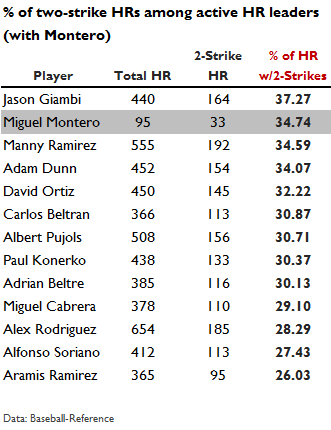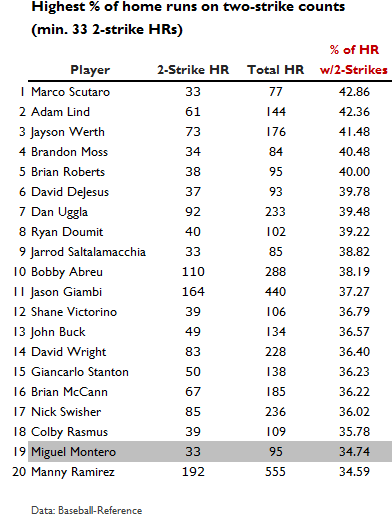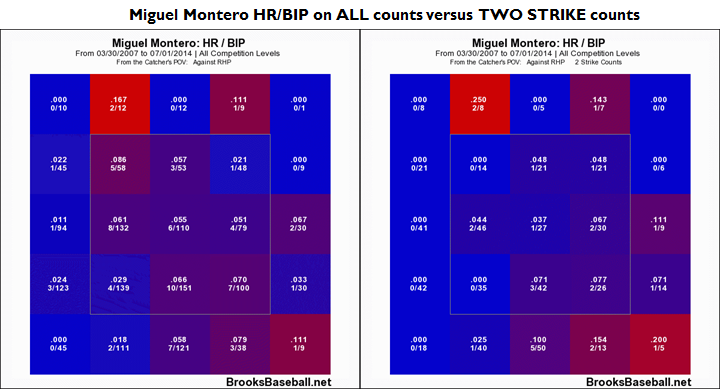Miguel Montero’s Two Strike Power
Miguel Montero is tied with Giancarlo Stanton for something related to power. The two hitters each have six home runs on two strike counts. That ranks tenth most in baseball this season, and coincides with a trend throughout the game that hitters aren’t afraid to swing for the fences, regardless of the count. For Montero, hitting long balls when faced with a two-strike count is nothing new. The catcher has a knack for doing so over his career. Let’s take a deeper look.
Of Montero’s 95 career home runs, over one-third of them have come when facing two strikes. An impressive total when comparing him against the game’s best home run hitters. Among active HR leaders (and we will include A-Rod and Manny), the percentage of Montero’s home runs that come on two strikes ranks quite high.
Of course, since the table above includes active home run leaders, it doesn’t necessarily consider the most frequent two-strike power hitters in terms of percentage of their total home runs, but instead looks at which players hit the most home runs overall. We can look at another table that includes all active players with at least as many two-strike home runs as Montero (33), and see how his percentage to his total home run count stacks up.
Of the 100 active players with as many two-strike home runs as Montero, he ranks 19th most frequent. A long-winded way of saying that Montero hits a high percentage of his home runs when there are two strikes compared to most hitters in baseball.
What makes Montero so powerful in two-strike counts?
The majority of Montero’s power comes against right-handed pitching. Ten of his eleven home runs this season, and eighty of his career 95 home runs, have come against righties. And a big reason for this is his ability to connect on offspeed pitches for long balls. Right-handed pitchers tend to use their change-up more often against lefties, so Montero sees a greater percentage of change-ups, particularly with two strikes, when facing right-handed pitching. Fifteen percent of Montero’s two-strike home runs have come against a change-up from a righty. His HR% on two-strikes against change-ups is 2.16%, by far the highest of any pitch he faces. Despite seeing over twice as many sinkers and five times as many four-seam fastballs in two-strike counts, he has hit more home runs off change-ups than either of the hard-type pitches.
Beyond pitch type, we can look at Montero’s zone profile for home runs on balls in play to see another interesting trend with two strike counts.
Usually, pitches down in the zone are harder to hit for long balls. As the zone profiles above demonstrate, Montero has had an uncanny ability throughout his career to hit pitches lower in the strike zone for home runs when there are two strikes in the count. Nine of the 13 home runs hit by Montero on pitches below the strike zone came with two strikes.
Miguel Montero has hit eleven home runs this season, including six in the month of June. More than half, six, of his home runs have come with two strikes in the count. What we are finding with Montero is that pitchers don’t necessarily find safety, when it comes to power, in situations that are usually “comfortable” or favorable. Right-handers using their change-up against his lefty bat are often times victimized. And keeping the ball low in the zone doesn’t help much either. The point is that when there are two strikes on Montero, don’t expect him to choke up on the bat, flail at a righty’s out-pitch, or ground out on a ball low in the zone. Look for power!
Statistics courtesy of Baseball-Reference and Brooks Baseball.One Response to Miguel Montero’s Two Strike Power
Leave a Reply Cancel reply
Recent Posts
@ryanpmorrison
 Best part of Peralta’s 108 mph fliner over the fence, IMHO: that he got that much leverage despite scooping it out… https://t.co/ivBrl76adF, Apr 08
Best part of Peralta’s 108 mph fliner over the fence, IMHO: that he got that much leverage despite scooping it out… https://t.co/ivBrl76adF, Apr 08 RT @OutfieldGrass24: If you're bored of watching Patrick Corbin get dudes out, you can check out my latest for @TheAthleticAZ. https://t.co/k1DymgY7zO, Apr 04
RT @OutfieldGrass24: If you're bored of watching Patrick Corbin get dudes out, you can check out my latest for @TheAthleticAZ. https://t.co/k1DymgY7zO, Apr 04 Of course, they may have overtaken the league lead for outs on the bases just now, also...
But in 2017, Arizona ha… https://t.co/38MBrr2D4b, Apr 04
Of course, they may have overtaken the league lead for outs on the bases just now, also...
But in 2017, Arizona ha… https://t.co/38MBrr2D4b, Apr 04 Prior to the games today, there had only been 5 steals of 3rd this season (and no CS) in the National League. The… https://t.co/gVVL84vPQ5, Apr 04
Prior to the games today, there had only been 5 steals of 3rd this season (and no CS) in the National League. The… https://t.co/gVVL84vPQ5, Apr 04 RT @OutfieldGrass24: Patrick Corbin has a WPA of .318 and it's only the fifth inning., Apr 04
RT @OutfieldGrass24: Patrick Corbin has a WPA of .318 and it's only the fifth inning., Apr 04
Powered by: Web Designers@outfieldgrass24
 RT @OJCarrascoTwo: Read this from the world famous, @OutfieldGrass24 https://t.co/cHUie1I5Le, 7 mins ago
RT @OJCarrascoTwo: Read this from the world famous, @OutfieldGrass24 https://t.co/cHUie1I5Le, 7 mins ago RT @TheAthleticAZ: A great source, our @ZHBuchanan and @OutfieldGrass24, for #DBacks info - and MLB Network agrees. https://t.co/QUNql4ol79, 23 mins ago
RT @TheAthleticAZ: A great source, our @ZHBuchanan and @OutfieldGrass24, for #DBacks info - and MLB Network agrees. https://t.co/QUNql4ol79, 23 mins ago RT @CrashStL: We have a good guest list for tonights @CardsNation247 Podcast. Joining @_ChrisLollis and @ToR_Ron75 will be… https://t.co/BSwCRpaGVk, 2 hours ago
RT @CrashStL: We have a good guest list for tonights @CardsNation247 Podcast. Joining @_ChrisLollis and @ToR_Ron75 will be… https://t.co/BSwCRpaGVk, 2 hours ago RT @JohnStolnis: Hittin' Season #237 is here!
@Mike_Ferrin talks me into A.J. Pollock and bums me out that he doesn't think Robbie… https://t.co/wyEbHLeDBL, 3 hours ago
RT @JohnStolnis: Hittin' Season #237 is here!
@Mike_Ferrin talks me into A.J. Pollock and bums me out that he doesn't think Robbie… https://t.co/wyEbHLeDBL, 3 hours ago RT @JonHeyman: Reds are among teams pursuing AJ Pollock and Dallas Keuchel, 3 hours ago
RT @JonHeyman: Reds are among teams pursuing AJ Pollock and Dallas Keuchel, 3 hours ago
Powered by: Web Designers








I think part of the fact that Miggy has so much power with two strikes is because he doesn’t try to hit home runs. He is a much better hitter when he cuts down on his swing and goes he other way. With two strikes, I think he does this and his numbers are very respectable. I remember Mark Grace would get so frustrated with Miggy whenever he swung out of his shoes and for a valid reason. He needs to cut his swing down and just put the ball in play like he usually (note: usually) does with two strikes.